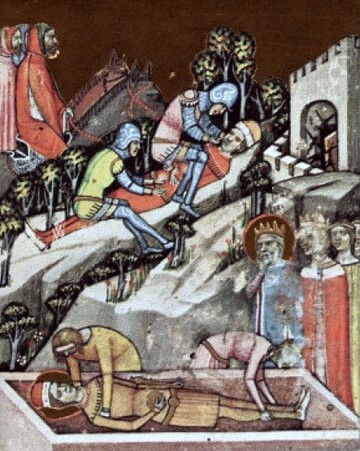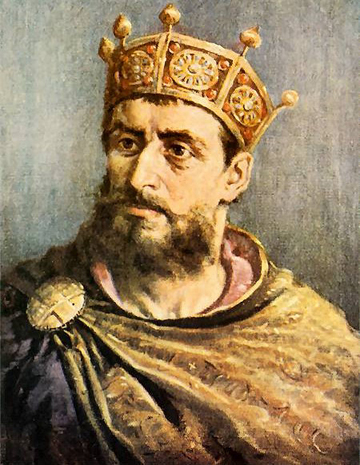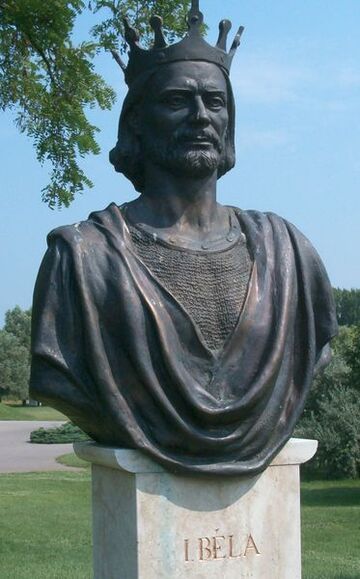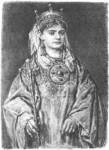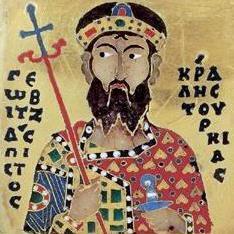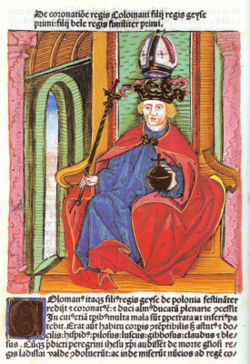maximum test » Geza "Giza" Arpad I (1045-1077)
Persönliche Daten Geza "Giza" Arpad I
- Spitzname ist Giza.
- Er wurde geboren zwischen 1040 und 1045Krakow
Poland. - Fetauft (im Alter von 8 Jahren oder später) von der Priestertumsvollmacht der HLT-Kirche am 14. Mai 1938.
- Alternative: Fetauft (im Alter von 8 Jahren oder später) von der Priestertumsvollmacht der HLT-Kirche am 14. Mai 1938.
- Alternative: Fetauft (im Alter von 8 Jahren oder später) von der Priestertumsvollmacht der HLT-Kirche am 14. Mai 1938.
- Berufe:
- Konge.
- Roi, de Hongrie.
- (Misc Event) von 1074 bis 1077Magyarország / Hungary.
- Er ist verstorben am 25. April 1077Nyitra - Nitra
Magyarország - Hungary (present Slovakia). - Er wurde beerdigt im Jahr 1077Boldogságos Szűz kadedrális - cathedral Blessed Virgin of Vác
Magyarország - Hungary. - Ein Kind von Béla Арпад und Richeza Adelaide Mieszkówna Piast
- Diese Information wurde zuletzt aktualisiert am 23. Dezember 2019.
Familie von Geza "Giza" Arpad I
Er hat eine Beziehung mit Sophie - Zsófia van Loon.
Kind(er):
Notizen bei Geza "Giza" Arpad I
GIVN Geza I, King
SURN Hungary
AFN 881B-X4
STAT SUBMITTED
DATE 9 SEP 2000
TIME 13:15:31
GIVN Geza I, King
SURN Hungary
AFN 881B-X4
STAT SUBMITTED
DATE 9 SEP 2000
TIME 13:15:31
Konge av Ungarn 1074 - 1077.
Geza kom på tronen etter å ha slått sin fars brorsønn, Salomon.
See message #1777.
Géza I of Hungary
From Wikipedia, the free encyclopedia.
Géza I (Slovak: Gejza) (c. 1040 – 1077) was the king of the Kingdom of Hungary from 1074 to 1077.
For his coronation, Géza received a crown from Byzantine Emperor Michael VII Dukas that was incorporated with the ancient crown of King Stephen I. Géza's short rule was characterized by general disorder in the kingdom. He did, however, capture Croatia from his brother-in-law Dmitar Zvonimir. He married twice; first to Sophia von Looz, daughter of the Count of Looz, and secondly to Synadene, a niece of Emperor Nicephorus III. By his first marriage, he had two children:
Coloman of Hungary
Prince Álmos
Géza died on April 25, 1077 and was succeeded by his brother Ladislaus I. Géza is buried at Vác.
Preceded by:
Solomon King of Hungary Succeeded by:
Ladislaus I
See message #1777.
See message #1777.
See message #1777.
GIVN Geza I, King
SURN Hungary
AFN 881B-X4
STAT SUBMITTED
DATE 9 SEP 2000
TIME 13:15:31
{geni:about_me} http://www.friesian.com/perifran.htm#bohemia
http://epa.oszk.hu/01500/01536/00010/pdf/UJ_1979_015-028.pdf
http://finnholbek.dk/getperson.php?personID=I26478&tree=2
http://fmg.ac/Projects/MedLands/HUNGARY.htm#GezaIA
'''GÉZA ([in Poland] [1044/45]-25 Apr 1077, bur Vac)'''. The Gesta Hungarorum names "Geichæ et Ladislai" as sons of "fratris sui Belæ" when recording that King András obtained their agreement to the future succession of his son Salomon[475]. The Kronika Węgiersko-Polska names "Geyzam et Ladislaum" as the two older sons of "Bela" and his wife "rex Polonie filiam", adding that they were both born in Poland[476]. He succeeded his cousin in 1074 as GÉZA I King of Hungary.
- see below.
http://fmg.ac/Projects/MedLands/HUNGARY.htm#GezaIB
'''GÉZA''', son of BÉLA I King of Hungary & his wife [Ryksa] of Poland ([in Poland] [1044/45]-25 Apr 1077, bur Vac).
*m firstly ([1062]) [SOPHIE de Looz, daughter of EMMO Comte de Looz & his wife ---] (before [1044/46]-[1065]).
*m secondly ([1066/75]) --- Synadene, daughter of THEODULOS Synadenos & his wife --- Botaneiatissa.
------------------------------------
'''Geisa I Arpád, King of Hungary''' 1
M, #114086, b. circa 1044, d. 1077
Last Edited=8 Mar 2007
'''Geisa I Arpád, King of Hungary''' was born circa 1044. (1) He was the son of Béla I Arpád, King of Hungary. (1) He married Synadene Synadenos, daughter of Theodore Synadenos. (1) He died in 1077. (1)
Geisa I Arpád, King of Hungary succeeded to the title of King Geisa I of Hungary in 1074. (1)
Children of Geisa I Arpád, King of Hungary and Synadene Synadenos
-1. Almus Arpád, Duke of Croatia+ d. 1129 (1)
-2. Koloman Arpád, King of Hungary+ d. 1114 (1)
I. Géza
Magyarország királya
Uralkodott 1074-1077
Megkoronázták 1074
Született 1040 körül Lengyelország
Elhunyt 1077.04.25.
?
Nyughelye A váci Boldogságos Szűzről elnevezett székesegyházban temették el.
Elődje Salamon
Utóda I. Szent László
Felesége 1. Zsófia, Arnulf belga-limburgi herceg lánya
2. Synnadené, bizánci patríciuslány
Gyermekei Könyves Kálmán, Álmos herceg
Dinasztia Árpád-ház
Apja I. Béla
Anyja Richeza lengyel hercegnő
===Utódai [szerkesztés]===
*Gézának első feleségétől, '''Zsófiá'''tól két fia maradt:
#Kálmán (a későbbi Könyves Kálmán király) és
#Álmos.
*Második felesége '''Szünadéné''', Niképhorosz Botaneiatész bizánci vezér unokahúga volt, tőle egy leány,
#Katalin született.
Forrás:
http://hu.wikipedia.org/wiki/I._G%C3%A9za
--------------------
http://en.wikipedia.org/wiki/G%C3%A9za_I_of_Hungary
==Géza I of Hungary==
From Wikipedia, the free encyclopedia
Géza I (Hungarian: I. Géza, Slovak: Gejza I) (c. 1040 – 25 April 1077), King of Hungary (1074-1077). During King Solomon's rule he governed, as Duke, one third of the Kingdom of Hungary. Afterwards, Géza rebelled against his cousin's reign and his followers proclaimed him king. However, he never achieved to strengthen his position, because King Solomon could maintain his rule over the Western part of the kingdom.
Early years
Géza was the eldest son of the future King Béla I of Hungary and his wife Adelaide/Rixa of Poland. When Géza was born, his parents were living in the court of his mother's brother, King Casimir I of Poland, because Béla had been obliged to leave Hungary after his father made an unsuccessful attempt against his cousin, King Stephen, the first King of Hungary.
Géza was probably his pagan name, because he was baptized Magnus. In 1048, the family moved to Hungary, where his father received as appanage one third of Hungary ("Tercia pars Regni") from his brother, King Andrew I of Hungary who had acquired the throne from King Peter after a pagan revolt. Following his accession, King Andrew I had to face the attacks of Henry III, Holy Roman Emperor whose supremacy had been acknowledged by King Peter. King Andrew I andDuke Béla cooperated closely against the German attacks and they could preserve Hungary's independence. However, they cooperation began to loosen from 1053 when the king fathered a son, Solomon, because from that time he wanted to ensure his son's inheritance against his brother, who pursuant to the old Hungarian costums, as the oldest member of the royal family, could lay claim to the throne in case of the king's death.
In 1057, King Andrew I had Solomon crowned to ensure his accession, and Géza had to participate in the coronation together with his father and his brothers, Ladislaus and Lampert. However, Duke Béla and his sons left the country in 1059 and they returned with Polish troops in the next year. King Andrew I lost two battles against his brother and died, and after his death Béla was crowned on 6 December 1060.
During his father's reign, Géza was his main adviser and after his father's fatal accident it was he who administered the defence of the country against the German troops which entered Hungary in order to ensure Solomon's rule whohad escaped to Duitsland in 1060. After his father's death on 11 September 1063, Géza offered to accept's his cousin's rule if he received his father's former duchy. However, King Solomon refused the offer and the superiority of his troops obliged Géza and his brothers to leave Hungary and they went to Poland. However, after the withdrawal of the German army, they came back to Hungary followed by troops King Bolesław II of Poland, their maternal cousin, provided them.
The parties, however, wanted to avoid the civil war and therefore they accepted the mediation services of the bishops, and they made an agreement on 20 January 1064 in Győr. Under the agreement Géza and his brothers accepted Solomon's rule, and they received their father's former duchy, i.e., the one third of Hungary.
[edit]Duke of Tercia pars Regni
After the conclusion of the peace, King Solomon and his three cousins celebrated Easter together in Pécs. However, when a fire broke out, the two parties accused the other's followers of incerdiarism. The bishops had to intervene again in order to appease the king and the dukes. At that time, Géza married Sophia who was probably a daughter of a German count.
In the next years, Géza and his brothers collaborated successfully with the king. In 1067, they led an army together to provide assistance to Géza's brother-in-law, King Dmitar Zvonimir of Croatia against Venice. In 1068, when thePechenegs had overrun the territories of Transylvania, Géza, his brothers and the king went together against them and they won a victory at Kerlés. In 1071, King Solomon and the dukes led a campaign against the Byzantine Empire and laid siege to the fortress of Belgrade. The siege lasted two months, and the Greek commander surrendered the fort to Géza not to the king. Moreover, Géza denied to hand over the king's share of the booty and set the Greek captives free without the king's permission.
Having the Byzantine troops reoccupied Belgrade in the next year, Géza and King Solomon led their armies together against the Greeks, but Géza left his two brothers behind, because he was worrying about that the king's partisans would try to occupy their duchy during their absence. The campaign was a total failure, because the king and the duke were not able to cooperate during the siege any more.
During 1073, both King Solomon and his cousins were preparing for the coming struggle. The king sent his envoys to his brother-in-law, King Henry IV of Duitsland, while Géza and his brothers were seeking the help of their Polish andCzech relatives. In the beginning of 1074, before the Polish and Czech troops arrived, King Solomon led his armies against the dukes' territory and defeated Géza's troops on 26 February at Kemej. However, after the arrival of thereinforcement from Poland and Bohemia, the dukes' armies started a counter-attack and they won a decisive victory over King Solomon's troops on 14 March in the Battle of Mogyoród.
[edit]King of Hungary
Following the Battle of Mogyoród, King Solomon ran to the Western borders of Hungary seeking help from King Henry IV, whose supremacy he accepted, while Géza was declared king by his followers. However, King Solomon could still maintain his rule over the Counties (megye) of Moson and Pozsony. In August 1074, the imperial troops invaded the Northern part of the kingdom and advanced till Vác, but the German king was obliged to return to his domain because ofthe Saxons' uprising.
Géza tried to obtain the international acknowledgement of his rule; therefore he sent embassies to Pope Gregory VII, who was struggling against the German king, and to Michael VII, Emperor of the Byzantine Empire. The pope claimedthe recognition of his supremacy over Hungary which Géza did not accept, but the Byzantine emperor sent a crown, that was later incorporated with the ancient crown of Hungary, to him and Géza was crowned by that crown because theancient crown was in the possession of King Solomon. At this time, Géza married a niece of Michael VII's military commander Nikephoros Botaneiates.
During his reign Géza set up the Abbey of Garamszentbenedek and finished the building of the cathedral of Vác. In 1076, he sent his troops led by his brother, Duke Ladislaus against Pozsony, but King Solomon could beat off the troops. After this failure, according to the chronicles, Géza, who had become more and more ill, was thinking of his abdication in favour of his opponent, but they did not reach an agreement.
He was buried in the cathedral of Vác.
==Marriages and children==
*∞1. c. 1062: '''Sophia''' (? – before 1075)
# King Coloman of Hungary (c. 1070 – 3 February 1116)
# Duke Álmos (c. 1070 – 1 September 1127)
*∞2. c. 1075: Unnamed daughter ("Synadene") of Theodulos Synadenos and his wife, the sister of the future Byzantine emperor Nikephoros Botaneiates (? – after 1079)
* Note from FARKAS Mihály László:
*Géza and Synadene had a daughter, (from the Hungarian version)
#Katalin
Legacy
Géza was succeeded by his brother, King Ladislaus I of Hungary who managed to establish himself on the throne after the abdication of King Solomon in 1081.
[edit]Sources
Kristó Gyula - Makk Ferenc: Az Árpád-ház uralkodói (IPC Könyvek, 1996)
Korai Magyar Történeti Lexikon (9-14. század), főszerkesztő: Kristó Gyula, szerkesztők: Engel Pál és Makk Ferenc (Akadémiai Kiadó, Budapest, 1994)
Magyarország Történeti Kronológiája I. – A kezdetektől 1526-ig, főszerkesztő: Benda Kálmán (Akadémiai Kiadó, Budapest, 1981)
Kosztolnyik, Z.J. Five Eleventh Century Hungarian Kings, 1981.
--------------------
Do NOT MERGE P L E A S E !
http://www.geni.com/people/II-Geza-ÁRPÁD-házi/6000000003897541628
and
http://www.geni.com/people/ÁRPÁD-házi-I-Géza-magyar-király/5287530087430075153
--------------------
Géza I (Hungarian: I. Géza) (c. 1040 – 25 April 1077), King of Hungary (1074-1077). During King Solomon's rule he governed, as Duke, one third of the Kingdom of Hungary. Afterwards, Géza rebelled against his cousin's reign and hisfollowers proclaimed him king. However, he never achieved to strengthen his position, because King Solomon could maintain his rule over the Western part of the kingdom.
Géza was the eldest son of the future King Béla I of Hungary and his wife Adelaide/Rixa of Poland. When Géza was born, his parents were living in the court of his mother's brother, King Casimir I of Poland, because Béla had been obliged to leave Hungary after his father made an unsuccessful attempt against his cousin, King Stephen, the first King of Hungary.
Marriages and children
m1.Sophia (? – before 1075)
#King Coloman of Hungary (c. 1070 – 3 February 1116)
#Duke Álmos (c. 1070 – 1 September 1127)
m2.Unnamed daughter ("Synadene") of Theodulos Synadenos and his wife, the sister of the future Byzantine emperor Nikephoros Botaneiates (? – after 1079)
--------------------
Géza I -Hungarian: I. Géza; c. 1040 – 25 April 1077 was King of Hungary from 1074 until his death. During King Solomon's rule he governed, as Duke, one third of the Kingdom of Hungary. Afterwards, Géza rebelled against his cousin's reign and his followers proclaimed him king. However, he never achieved to strengthen his position, because King Solomon could maintain his rule over the Western part of the kingdom.
Early years
Géza was the eldest son of the future King Béla I of Hungary and his wife Adelaide/Rixa of Poland. When Géza was born, his parents were living in the court of his mother's brother, King Casimir I of Poland, because Béla had been obliged to leave Hungary after his father made an unsuccessful attempt against his cousin, King Stephen, the first King of Hungary.
Géza was probably his pagan name, because he was baptized Magnus. In 1048, the family moved to Hungary, where his father received as appanage one third of Hungary ("Tercia pars Regni") from his brother, King Andrew I of Hungary who had acquired the throne from King Peter after a pagan revolt. Following his accession, King Andrew I had to face the attacks of Henry III, Holy Roman Emperor whose supremacy had been acknowledged by King Peter. King Andrew I andDuke Béla cooperated closely against the German attacks and they could preserve Hungary's independence. However, they cooperation began to loosen from 1053 when the king fathered a son, Solomon, because from that time he wanted to ensure his son's inheritance against his brother, who pursuant to the old Hungarian customs, as the oldest member of the royal family, could lay claim to the throne in case of the king's death.
In 1057, King Andrew I had Solomon crowned to ensure his accession, and Géza had to participate in the coronation together with his father and his brothers, Ladislaus and Lampert. However, Duke Béla and his sons left the country in 1059 and they returned with Polish troops in the next year. King Andrew I lost two battles against his brother and died, and after his death Béla was crowned on 6 December 1060.
During his father's reign, Géza was his main adviser and after his father's fatal accident it was he who administered the defence of the country against the German troops which entered Hungary in order to ensure Solomon's rule whohad escaped to Duitsland in 1060. After his father's death on 11 September 1063, Géza offered to accept his cousin's rule if he received his father's former duchy. However, King Solomon refused the offer and the superiority of his troops obliged Géza and his brothers to leave Hungary and they went to Poland. However, after the withdrawal of the German army, they came back to Hungary followed by troops King Bolesław II of Poland, their maternal cousin, provided them.
The parties, however, wanted to avoid the civil war and therefore they accepted the mediation services of the bishops, and they made an agreement on 20 January 1064 in Győr. Under the agreement Géza and his brothers accepted Solomon's rule, and they received their father's former duchy, i.e., the one third of Hungary.
Duke of Tercia pars Regni
After the conclusion of the peace, King Solomon and his three cousins celebrated Easter together in Pécs. However, when a fire broke out, the two parties accused the other's followers of incerdiarism. The bishops had to intervene again in order to appease the king and the dukes. At that time, Géza married Sophia who was probably a daughter of a German count.
In the next years, Géza and his brothers collaborated successfully with the king. In 1067, they led an army together to provide assistance to Géza's brother-in-law, King of Croatia Dmitar Zvonimir of Croatia against Venice. In 1068, when the Pechenegs had overrun the territories of Transylvania, Géza, his brothers and the king went together against them and they won a victory at Kerlés. In 1071, King Solomon and the dukes led a campaign against the Byzantine Empire and laid siege to the fortress of Belgrade. The siege lasted two months, and the Greek commander surrendered the fort to Géza not to the king. Moreover, Géza denied to hand over the king's share of the booty and set the Greek captives free without the king's permission.
Having the Byzantine troops reoccupied Belgrade in the next year, Géza and King Solomon led their armies together against the Greeks, but Géza left his two brothers behind, because he was worrying about that the king's partisans would try to occupy their duchy during their absence. The campaign was a total failure, because the king and the duke were not able to cooperate during the siege any more.
During 1073, both King Solomon and his cousins were preparing for the coming struggle. The king sent his envoys to his brother-in-law, King Henry IV of Duitsland, while Géza and his brothers were seeking the help of their Polish andCzech relatives. In the beginning of 1074, before the Polish and Czech troops arrived, King Solomon led his armies against the dukes' territory and defeated Géza's troops on 26 February at Kemej. However, after the arrival of thereinforcement from Poland and Bohemia, the dukes' armies started a counter-attack and they won a decisive victory over King Solomon's troops on 14 March in the Battle of Mogyoród.
King of Hungary
Following the Battle of Mogyoród, King Solomon ran to the Western borders of Hungary seeking help from King Henry IV, whose supremacy he accepted, while Géza was declared king by his followers. However, King Solomon could still maintain his rule over the Counties (megye) of Moson and Pozsony. In August 1074, the imperial troops invaded the Northern part of the kingdom and advanced till Vác, but the German king was obliged to return to his domain because ofthe Saxons' uprising.
Géza tried to obtain the international acknowledgement of his rule; therefore he sent embassies to Pope Gregory VII, who was struggling against the German king, and to Michael VII, Emperor of the Byzantine Empire. The pope claimedthe recognition of his supremacy over Hungary which Géza did not accept, but the Byzantine emperor sent a crown, that was later incorporated with the ancient crown of Hungary, to him and Géza was crowned by that crown because theancient crown was in the possession of King Solomon. At this time, Géza married a niece of Michael VII's military commander Nikephoros Botaneiates.
During his reign Géza set up the Abbey of Garamszentbenedek and finished the building of the cathedral of Vác. In 1076, he sent his troops led by his brother, Duke Ladislaus against Pozsony, but King Solomon could beat off the troops. After this failure, according to the chronicles, Géza, who had become more and more ill, was thinking of his abdication in favour of his opponent, but they did not reach an agreement.
He was buried in the cathedral of Vác.
Marriages and children
#1. c. 1062: Sophia (? – before 1075)
King Coloman of Hungary (c. 1070 – 3 February 1116)
Duke Álmos (c. 1070 – 1 September 1127)
#2. c. 1075: Unnamed daughter ("Synadene") of Theodulos Synadenos and his wife, the sister of the future Byzantine emperor Nikephoros Botaneiates (? – after 1079)
--------------------
Konge av Ungarn 1074 - 1077.
Geza kom på tronen etter å ha slått sin fars brorsønn, Salomon.
Tekst: Tore Nygaard
Kilder:
Mogens Bugge: Våre forfedre, nr. 1121. Bent og Vidar Billing Hansen: Rosensverdslektens forfedre, side 18.
--------------------
Géza I (Hungarian: I. Géza) (c. 1040 – 25 April 1077), King of Hungary (1074-1077). During King Solomon's rule he governed, as Duke, one third of the Kingdom of Hungary. Afterwards, Géza rebelled against his cousin's reign and hisfollowers proclaimed him king. However, he never achieved to strengthen his position, because King Solomon could maintain his rule over the Western part of the kingdom.
Géza was the eldest son of the future King Béla I of Hungary and his wife Adelaide/Rixa of Poland. When Géza was born, his parents were living in the court of his mother's brother, King Casimir I of Poland, because Béla had been obliged to leave Hungary after his father made an unsuccessful attempt against his cousin, King Stephen, the first King of Hungary.
Marriages and children
m1.Sophia (? – before 1075)
#King Coloman of Hungary (c. 1070 – 3 February 1116)
#Duke Álmos (c. 1070 – 1 September 1127)
m2.Unnamed daughter ("Synadene") of Theodulos Synadenos and his wife, the sister of the future Byzantine emperor Nikephoros Botaneiates (? – after 1079)
--------------------
http://en.wikipedia.org/wiki/G%C3%A9za_I_of_Hungary
859747692. Kong Geisa I BELASON av Ungarn was born about 1040.(20072) He was a Konge between 1074 and 1077 in Ungarn.(20073) Han kom på tronen etter å ha slått sin fars brorsønn Slomon He died on 15 Apr 1077.(20074) He was married to N. Synadena THEODULSDTR av Grekenland in 1073.
RESEARCH NOTES:
King of Hungary (1074-1077)
He reigned from 1074 to 1077.
Zeitbalken Geza "Giza" Arpad I
Diese Funktionalität ist Browsern mit aktivierten Javascript vorbehalten.
Klicken Sie auf den Namen für weitere Informationen.
Verwendete Symbole:  Großeltern
Großeltern
 Eltern
Eltern
 Geschwister
Geschwister
 Kinder
Kinder
 Großeltern
Großeltern
 Eltern
Eltern
 Geschwister
Geschwister
 Kinder
Kinder
Die angezeigten Daten haben keine Quellen.
Anknüpfungspunkte in anderen Publikationen
Diese Person kommt auch in der Publikation vor:Historische Ereignisse
Taufdatum 14. Mai 1938
- Die Temperatur am 14. Mai 1938 lag zwischen 8,1 °C und 25,2 °C und war durchschnittlich 17,8 °C. Es gab 9,9 Stunden Sonnenschein (63%). Die durchschnittliche Windgeschwindigkeit war 3 Bft (mäßiger Wind) und kam überwiegend aus Süd-Osten. Quelle: KNMI
- Koningin Wilhelmina (Huis van Oranje-Nassau) war von 1890 bis 1948 Fürst der Niederlande (auch Koninkrijk der Nederlanden genannt)
- Von 24. Juni 1937 bis 25. Juli 1939 regierte in den Niederlanden das Kabinett Colijn IV mit Dr. H. Colijn (ARP) als ersten Minister.
- Im Jahr 1938: Quelle: Wikipedia
- Die Niederlande hatte ungefähr 8,6 Millionen Einwohner.
- 24. Februar » Das US-amerikanische Unternehmen DuPont stellt die ersten Zahnbürsten mit Nylon-Borsten her.
- 30. März » Der achte Prototyp des deutschen Jagdflugzeugs Heinkel He100, die He100V8, erreicht eine Durchschnittsgeschwindigkeit von 746,61km/h, was zu dieser Zeit den absoluten Geschwindigkeitsweltrekord bedeutet.
- 3. April » Im Praterstadion in Wien findet das „Anschlussspiel“ zwischen einer deutschen und einer österreichischen Fußballauswahl statt.
- 22. Juni » Im New Yorker Yankee Stadium verliert Max Schmeling im Kampf um die Boxweltmeisterschaft im Schwergewicht gegen Joe Louis durch technischen KO in der ersten Runde.
- 24. Juli » Die erste Durchsteigung der Eiger-Nordwand (die am 21. Juli begann) wird erfolgreich abgeschlossen.
- 30. September » Die Tschechoslowakei wird im Münchener Abkommen infolge der Appeasement-Politik der Westmächte gezwungen, die Sudetengebiete an das Deutsche Reich abzutreten.
Gleicher Geburts-/Todestag
- 1074 » Hermann I. von Baden, Markgraf
- 1077 » Géza I., König von Ungarn
- 1112 » Gaudry, Bischof von Laon
- 1116 » Bernhard von Tiron, Einsiedler und Klostergründer
- 1124 » Bruno von Bretten, Erzbischof von Trier
- 1185 » Antoku, Kaiser von Japan
Über den Familiennamen Arpad
- Zeigen Sie die Informationen an, über die Genealogie Online verfügt über den Nachnamen Arpad.
- Überprüfen Sie die Informationen, die Open Archives hat über Arpad.
- Überprüfen Sie im Register Wie (onder)zoekt wie?, wer den Familiennamen Arpad (unter)sucht.
Die maximum test-Veröffentlichung wurde von Ard van Bergen erstellt.
Geben Sie beim Kopieren von Daten aus diesem Stammbaum bitte die Herkunft an:
Ard van Bergen, "maximum test", Datenbank, Genealogie Online (https://www.genealogieonline.nl/maximum-test/I5287530087430075153.php : abgerufen 14. Januar 2026), "Geza "Giza" Arpad I (1045-1077)".
Ard van Bergen, "maximum test", Datenbank, Genealogie Online (https://www.genealogieonline.nl/maximum-test/I5287530087430075153.php : abgerufen 14. Januar 2026), "Geza "Giza" Arpad I (1045-1077)".
